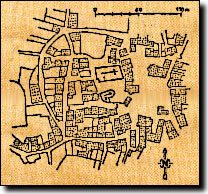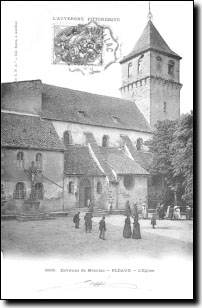

Medieval village in High-Auvergne

|

Medieval village in High-Auvergne |
|
|
History |
 If today its history melt
France one’s, once Pleaux participated actively in the development of
country. Perhaps it had no famous individuality nor sumptuous monuments but
it had men devoted to the public interest. It belonged to lords, good or
bad. It possessed a priory, charitable establishments, and became one of
the greatest intellectual centers of the region with its secondary school
(Petit Séminaire). Turbulent moments of the history of France shook
it like wars of religion, French revolution and second world war. Earth of
migrants among all, the small city has known from 16th century and knows
always the rural depopulation. But tradition and Christendom earth, its steeples
remain for us a landmark and balance . ..
If today its history melt
France one’s, once Pleaux participated actively in the development of
country. Perhaps it had no famous individuality nor sumptuous monuments but
it had men devoted to the public interest. It belonged to lords, good or
bad. It possessed a priory, charitable establishments, and became one of
the greatest intellectual centers of the region with its secondary school
(Petit Séminaire). Turbulent moments of the history of France shook
it like wars of religion, French revolution and second world war. Earth of
migrants among all, the small city has known from 16th century and knows
always the rural depopulation. But tradition and Christendom earth, its steeples
remain for us a landmark and balance . ..
| Origins to 11th century |
Middle Ages | Lords and
co-lords |
| Wars of Religion |
 Pleaux, formerly Pleus and
Pleux, in provincial dialect Pléou, has its name derived from Latin
word plebs, plebes, parish, baptismal church. According to M. Charles Giraud,
institute’s member, cities or villages, whose name begins with plé,
plou, pleu, plo, should have been founded by monks.
Pleaux, formerly Pleus and
Pleux, in provincial dialect Pléou, has its name derived from Latin
word plebs, plebes, parish, baptismal church. According to M. Charles Giraud,
institute’s member, cities or villages, whose name begins with plé,
plou, pleu, plo, should have been founded by monks.
There was in Pleaux a priory of the Saint-Benoît’s Order, whose existence is undoubtedly established towards the middle of 8th century; it depended on the abbey of Charroux, near Poitiers. Monks installed in Pleaux found an embryo of city around the Saint-Jean’s church. The providential presence of these monks made prosper in all points the city; they built, created, organized around them for the good of all. Their monastery was the vast machicolated house "Duclaux" close at end to the Saint-Sauveur’s church. In 1095, the monastery had a distinguished boarder of mark in the person of Saint-Etienne of Obazine, eremitic and founder of the famous abbey.
 |
Pleaux according to a plan of alignment of 1813 and the survey
of 1823.
1. Saint-Sauveur’s church, today parish church |
Pleaux had formerly two churches, indeed to the paleochristian period the baptistry was a distinct structure of the church and dedicated to Saint Jean-Baptiste, it is only from 7th-8th centuries that it was gradually replaced by baptismal funds installed in the church itself. One of churches, that subsists alone today, was dedicated to Saint-Sauveur. The other, destroyed between 1813 and 1817, was dedicated to Saint Jean-Baptiste and stood to approximately 25 meters of the precedent (according to a municipal deliberation minute that mentions 16th January 1817 debris of the Saint-Jean’s church). The town hall occupies the site of the ancient Saint-Jean’s church. To 17th and 18th centuries, this sanctuary, situated in the cemetery, hold again baptismal funds of the parish and was considered as the primitive church.
The Saint-Jean Baptiste’s church is formed like a Latin cross of
approximately 20 meters of long on 17 of large and was separated of Saint-Sauveur
for a short distance by the cemetery (transferred in 1809 to its current
site, Ignole’s street).
 |
Saint-Sauveur’s church |
The Saint-Sauveur’s church had three chapels to the North and two to the Midday. The steeple with its four bells was found on the sacristy and on the choir, the clock’s tower. Down the chapels, the last one to left enter some, is the sacristy. In 1793 the western tower was destroyed abreast of the roof, the second tower had its salvation only to the necessity to have a highest point for the clock. Today the church has been reconstructed and altered to various periods, it is in 1960 that an important reconstitution gave back it its ancient character and its authentic beauty.
| Summary | History |
Discovery | Sports &
Leasures | Surroundings |
| Access | Accomodation
& Restaurant | Bibliography |